Your rendezvous with 25 masters.
The museum door closes behind you, everyday life recedes into the background, and you step into a unique and inspiring world. At the Rosengart Collection you will encounter works by Pablo Picasso, Paul Klee and 23 other Impressionist and Classic Modernist artists.
List
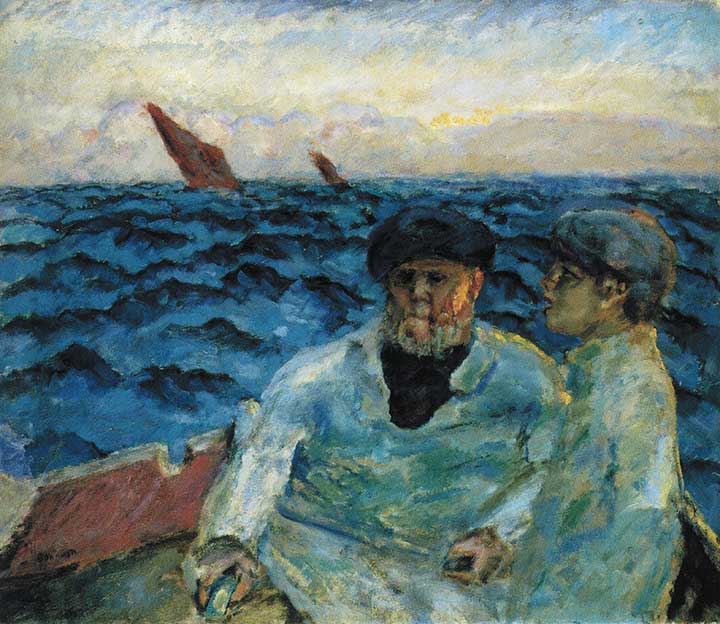
1867 - 1947
Pierre Bonnard
In Woman with Black Stockings (c. 1900), the emphasis is no longer on surface, but on the plasticity and volumes of this figure, wonderfully modelled in light and seated on a chair.
As such, the painting announces the end of Bonnard’s “Nabi” phase and his development of an individual style. It is one in a series of nude portraits (begun in 1893) of the artist’s companion and future wife Marie Boursin, known as Marthe.
In the cast of the sunlight and the variegated blues of the water and the fishermen’s smocks in Fishermen in a Boat, Brittany (1907) Bonnard also reveals himself to be a colourist of great subtlety .
Picture:
Pierre Bonnard, Fishermen in a Boat, Brittany, 1907

1882 - 1963
Georges Braque
Table with Pipe (1912) is an outstanding example of Analytical Cubism. In The Program (Tivoli Cinema) (1913), Georges Braque includes a cinema program and strips of unprinted, coloured paper, which are pasted onto the canvas. In places, the white primed canvas is worked with charcoal. Postdating these Cubist paintings by a few years, the still-life Glass and Fruit (c. 1922) represents another important phase in the artist’s creative life.
During this period of relative stability, which ended with the Wall Street Crash of 1929, Cubist elements, such as the printed letters seen here, continue to feature in Braque’s work.
Picture:
Georges Braque, The Program (Tivoli Cinema), 1913

1898 - 1976
Alexander Calder
The metal sculpture Mobile (c. 1953) by the American sculptor Alexander Calder is remarkable for the grace and elegance of its forms. Calder made the acquaintance of Joan Miró in Paris in 1928. Their lifelong friendship, based on mutual respect, had a strong influence not least on their artistic production.
Picture:
Alexander Calder, Mobile, ca 1953

1839 - 1906
Paul Cézanne
Rather than simply describing what is there, Cézanne was concerned with rendering visible the underlying structures and a thematic order. This is evident in his still-lifes from a relatively early stage.
Already in evidence in Milk-Jug and Lemon (c. 1879) is the artist’s extremely free use of the brush, as can be seen in the bold strokes with which he renders the cloth.
He makes even more systematic use of this approach in his hatching and “colour passages” in L`Estaque, the Village and the Sea (1882). The artist repeatedly drew inspiration from the village of L’Estaque: from its Mediterranean vegetation, from its olive trees and pines, with their closed forms, and from its charming colour contrasts. Since araound 1875, Cézanne had been engaging with the theme of “bathers,” such a conspicuous feature of his work. Study of Bathers (1900–06), an entrancing work composed of loose and yet precise brushstrokes, is a beautiful example of his exploration of this motif.
Picture:
Paul Cézanne, L`Estaque, the Village and the Sea, 1882

1887 - 1985
Marc Chagall
Many works in the Rosengart Collection are personally dedicated to Siegfried and Angela Rosengart, showing a profound friendship with Chagall. This is also true of the palette presented by the artist to Siegfried Rosengart by way of thanks for a piece of advice given him by the art dealer.
Chagall’s works possess an unmistakable style of their own. They blend real and fantasy worlds, the latter populated by beasts, fabulous beings, or angels, for example in The Models (1965) and The Red Sun (1983).
Chagall’s most beloved subjects were peasant Russia, as in Russian Village, pairs of lovers, as in Evening at the Window, and time and again the Bible, as in David Mourning his Son Absalom and Christ and the Clock. All these works were painted in the 1950s.
Picture:
Marc Chagall, Evening at the Window, 1950

1877 - 1953
Raoul Dufy
Raoul Dufy’s The Old Port in Marseille (1908) was painted the same year as Utrillo’s Pinson Hill, Montmagny.
In its strong colourfulness, its juxtaposed areas of pure colour with no modelling of light and shade and the artist’s– in places–free choice of colour in his rendering of the water in the foreground, this work betrays Dufy’s engagement with the Fauvist style of painting. The artist had first encountered Fauvism in a 1905 exhibition that included works by Henri Matisse.
Following this experience, Dufy began to paint out of doors in the south of France.
Picture:
Raoul Dufy, The Old Port in Marseille, 1908

1866 - 1944
Wassily Kandinsky
The formal principle underlying Multiple Forms (1936), called Moody Forms by Kandinsky, is no longer geometric, but is based on biomorphic elements and their never-ending metamorphoses. In the lower left and upper right corners, amoeba- and larva-like (or perhaps embryonic) creatures can be seen floating against the dark background. Some of the abstract life forms in this work are reminiscent of nematode worms and other microorganisms.
Kandinsky found his inspiration for them in illustrations in the zoology volume of an encyclopaedia. This was discovered in his library along with treatises on the natural sciences and an illustrated article on the deep sea.
Picture:
Wassily Kandinsky, Multiple Forms, 1936

1879 - 1940
Paul Klee
One hundred and twenty-five wonderfully resonant watercolours, drawings, and oil paintings by Paul Klee form the second main focus of the Rosengart Collection. These works document each of the artist’s creative periods, with the watercolours and drawings starting from 1910. The works from the 1920s, such as the so-called square pictures (Harmony in Blue=Orange and Like a Window Panel) and shades of colour (Eros, Double tent) are fascinating for their geometric, sign-based vocabulary. They are followed by works based on organic forms, a mesh of freely drawn lines, or symbol-like logograms and loosely scattered signs, such as Abundance (1938) and Winter Sun (1938). Taken together, these drawings and paintings form a highly individualistic body of work that reflects the inexhaustible pictorial and narrative wealth of Paul Klee’s art. Among them is the drawing Little X (1938), the first Klee to be acquired by Angela Rosengart (at the age of sixteen).
“Art does not reproduce the visible; it renders visible.” This conviction of Klee’s, a poet among painters, makes perfect sense in the light of the supremely beautiful works in this unique Klee collection.
Picture:
Paul Klee, Queen of hearts, 1922

1881 - 1955
Henri Laurens
The bronze sculpture Seated Woman (1932) is on display in the Rosengart Collection next to Modigliani’s Portrait of Henri Laurens, Sitting (1915). Laurens created this sculpture using a figurative-Cubist language of form.
Picture:
Henri Laurens, Seated Woman, 1932
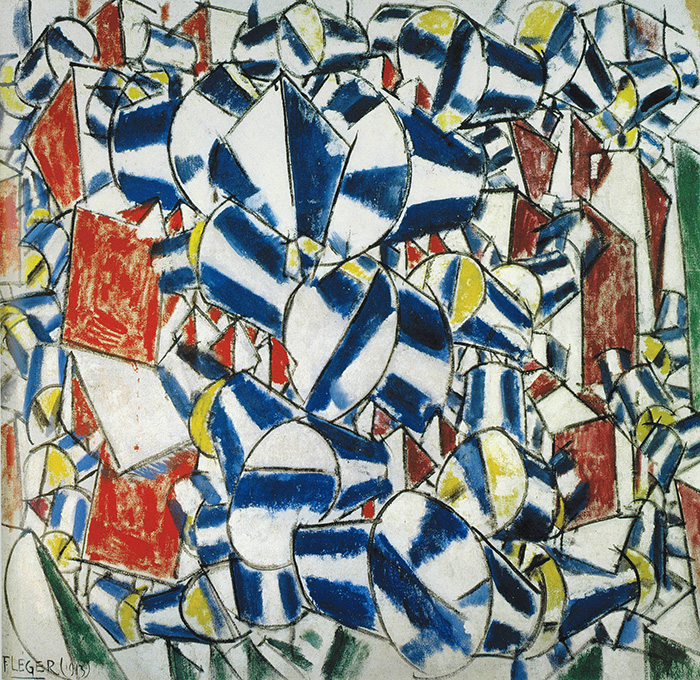
1881 - 1955
Fernand Léger
In Contrast of Forms (1913), the Rosengart Collection has on display the largest and most important work in the series of abstract paintings by the same name painted by Léger in 1913/14.
These are his boldest and least figurative works. At the centre of the work the forms coalesce into powerful strings of shapes suggesting space and depth.
Picture:
Fernand Léger, Contrast of Forms, 1913
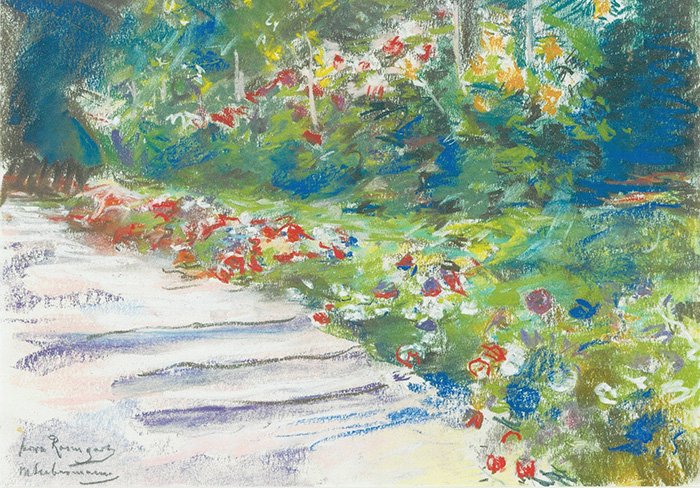
1847-1935
Max Liebermann
Max Liebermann is one of the most important exponents of German Impressionism. His palette grew lighter following a sojourn in Paris. The pastel Front Garden of the Villa at Wannsee, Berlin, dating from 1929, takes one of the key motifs of Liebermann’s late works, which were inspired by the artist’s large garden.
Picture:
Max Liebermann, Front Garden of the Villa at Wannsee, Berlin, 1929
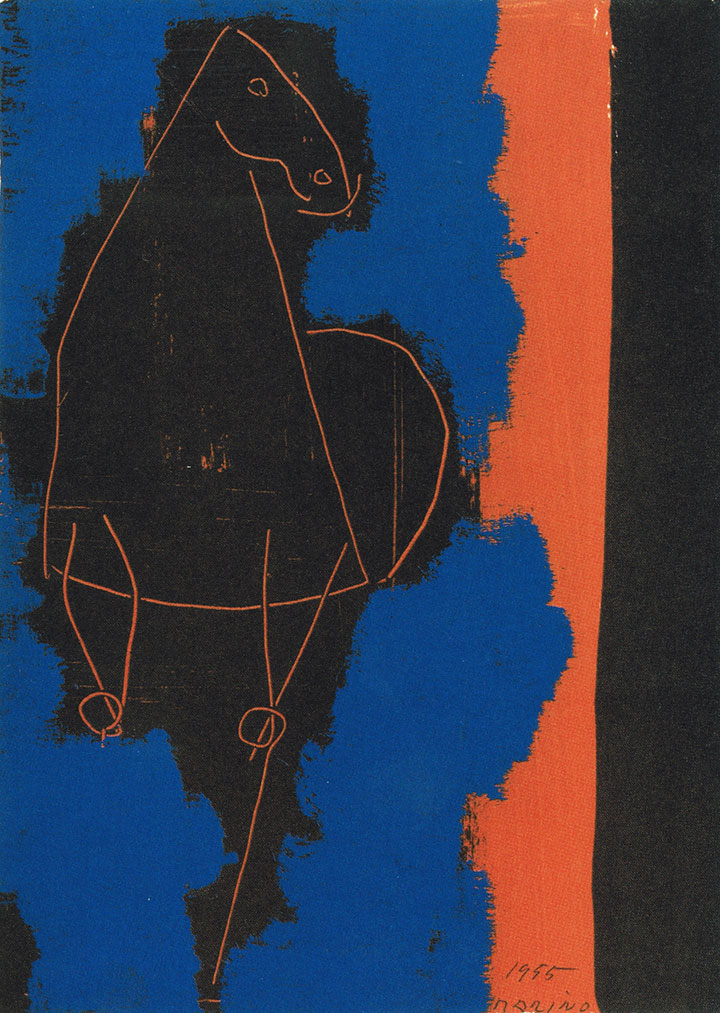
1901 - 1980
Marino Marini
In addition to his portraits and nudes, Marino Marini executed numerous variations on the theme of the equestrian figure, with riders that seem fused with their mounts, centaur-like. An example is Little Horseman (1950), a painted plaster sculpture made for Siegfried and Angela Rosengart in 1950. This work lends the motif of the horse and rider a remarkable vitality.
Marini turned to sculpture after 1928. Over the ensuing decades he made a large number of portrait busts that are unparalleled in twentieth century art for their sensitivity of execution, in particular displaying great psychological depth in the faces.
Marini’s credo was to be attuned to the spirit of a person, and this approach is exemplified in the bronze bust Portrait of Siegfried Rosengart (1960).
Picture:
Marino Marini, Little Horseman, 1950
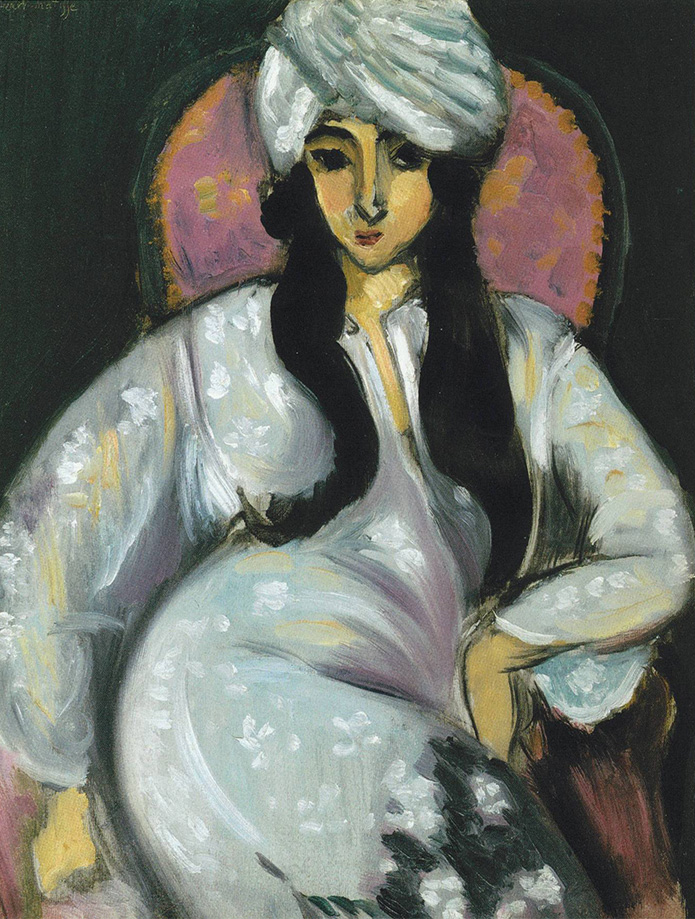
1869 - 1954
Henri Matisse
Matisse’s encounter with Middle Eastern culture during a trip to Morocco (1912) inspired him to embrace an oriental palette and a linear style of design. Some four years later, the artist painted Laurette with White Turban (1916), the (professional) model being a young Italian woman who sat for Matisse a number of times.
The late still-life Lemons and Saxifrages (1943) is a feast of colour that employs the primary colours (yellow, blue and red) as well as red’s complementary, green. Siegfried Rosengart used to call it The Dance of the Lemons.
Still-Life (1939), along with two other important drawings, is a wonderful example of Matisse the draughtsman. Out of charcoal he conjures a wide range of tonal values that correspond to the different colours. He achieves this not by means of hatching, but using an occasionally smudged stroke of varying thickness that often merely circumscribes a white space.
Picture:
Henri Matisse, Laurette with White Turban, 1916

1893 - 1983
Joan Miró
Joan Miró is represented in the Rosengart Collection with three works. At the beginning of the 1920s the artist distanced himself from the representational way of seeing, instead developing a visual language all of his own that consisted of signs, symbols and lines. As can be seen in Dancer II (1925), this approach nevertheless admitted certain concrete parallels with the real world.
In Study for the Circus Horse (1926), we discover the same highly succinct and yet decipherable visual language.
During the war years, Miró underwent a phase of extreme concentration and seclusion. The resulting works, exclusively on paper, include the eminently important and unusually large gouache Women, Bird, Stars (1942).
Picture:
Joan Miró, Dancer II, 1925

1884 - 1920
Amedeo Modigliani
This artist is known primarily for his female portraits, nudes and caryatids of clear and strikingly concise design. On display in the Rosengart Collection is one of the best examples of the series Caryatid (1913/14).
Modigliani also repeatedly painted his artist friends and colleagues in characteristic poses – as attested by the Portrait of Henri Laurens, Sitting (1915).
Although only a sketch, this work looks forward to the highly individual style later adopted by Modigliani for his portraits, as exemplified by his oval faces with narrow, pupil-less eyes.
Picture:
Amedeo Modigliani, Caryatid, 1913/14
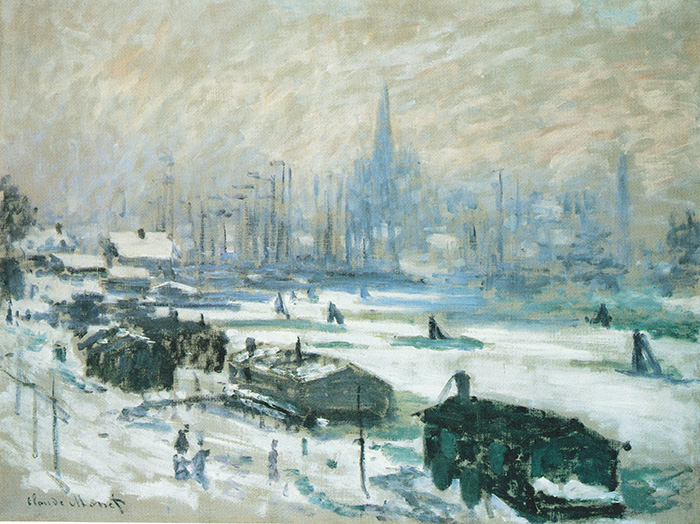
1840 - 1926
Claude Monet
Monet repeatedly turned to a motif that enjoyed widespread popularity among the Impressionists: the water. The light refracted in its surface or the surroundings reflected differently in the water depending on the time of day or year continually presented the painter with new challenges.
In Vernon Church, Fog (1894, incorrectly dated 1893 by the artist), Monet was fascinated by the reflections on a misty day. Snow in Amsterdam (1874) can be seen as encapsulating the Impressionists’ main preoccupation: instead of “merely” depicting scenes, they dedicated themselves to creating works that were snapshots of a specific moment, conveying a sense of randomness.
Picture:
Claude Monet, Snow in Amsterdam, 1874

1881 - 1973
Pablo Picasso
Thanks to Siegfried and Angela Rosengart’s friendship with Picasso, extending over several decades, with Siegfried and Angela Rosengart, Pablo Picasso, perhaps the twentieth century’s most stimulating artist, is represented in the Collection with 32 impressive paintings dating mainly from his late period. Moreover, Picasso’s artistic mastery and creative vitality are attested by around one hundred drawings, watercolours and graphic and sculptural works. This collection is complemented by some fascinating photographs by David Douglas Duncan.
The thematic diversity of Picasso’s work and his prolific pictorial imagination can be seen in works such as Women with Straw Hat on a Floral Background, Marie-Thérèse (1938) and Woman Playing with a Dog (1953).
In addition to further figure paintings, nudes and interiors from the 1950s and 1960s, Portrait of a Painter, after El Greco, dating from 1950, was the first painting to display what was to become an important theme in his late production: the paraphrasing of works by other artists.
In evidence in this work, as in Gentleman with a Pipe and Flowers (1968) and Rembrandtesque Figure and Cupid (1969), are Picasso’s undiminished stylistic freedom and his mastery of colour and choice of subject. Furthermore, the collection of large-format paintings dating from 1967 to 1969 is unique in Switzerland. For a long time, due to their new style, these works met with incomprehension among many collectors, critics and even friends of Picasso. They had nevertheless been selected spontaneously and unreservedly by Siegfried and Angela Rosengart immediately after their completion.
Picture:
Pablo Picasso, Women with Straw Hat on a Floral Background, Marie-Thérèse, 1938
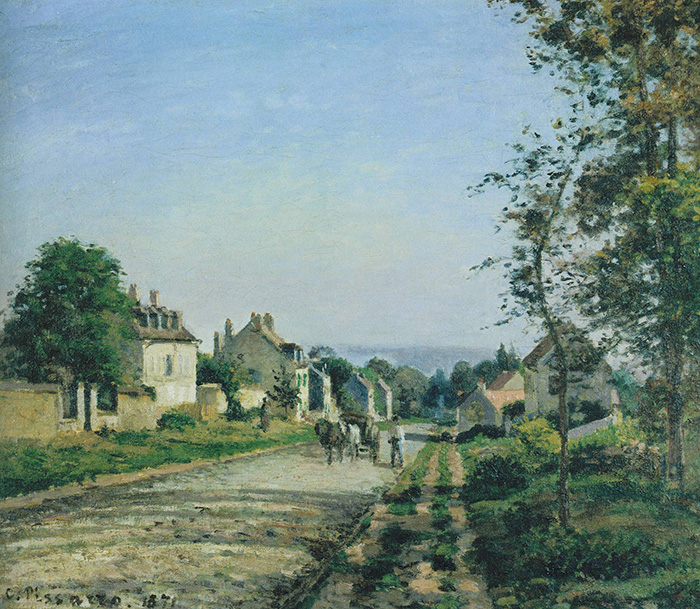
1830 - 1903
Camille Pissarro
The Rosengart Collection documents the main preoccupations of the Impressionists through a number of impressive works. Among them is the oldest in the Collection: Around Louveciennes, the Road (1871) by Camille Pissarro.
In his free handling of the leaves of the trees, which are applied as dabs of colour, in the play of the trees’ shadows on the village street and in the slightly hazy blue of the sky, Pissarro uses soft hues to capture the mood and atmosphere of a bright and lovely summer’s day. This is one of many pictures painted by Pissarro en plein air at Louveciennes, now a suburb of Paris.
Picture:
Camille Pisarro, Around Louveciennes, the Road, 1871
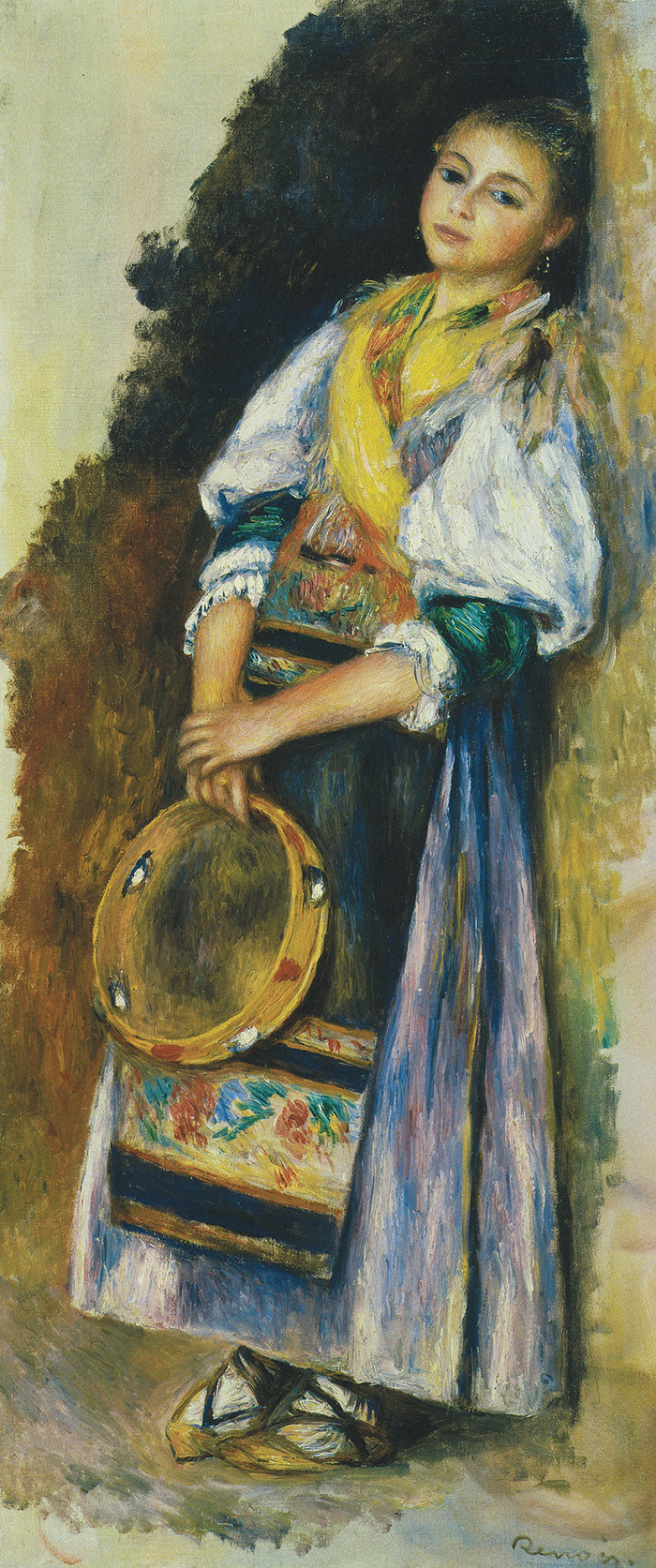
1841 - 1919
Pierre Auguste Renoir
Renoir is represented with two works in the Rosengart Collection.
From the beginning, the artist made a name for himself primarily as a portrait and figure painter. An impression of his great mastery is conveyed by the pastel Nude from Behind, dating from 1879, and the oil painting Italian Woman with Tambourine, dating from 1881.
Picture:
Pierre Auguste Renoir, Italian Woman with Tambourine, 1881
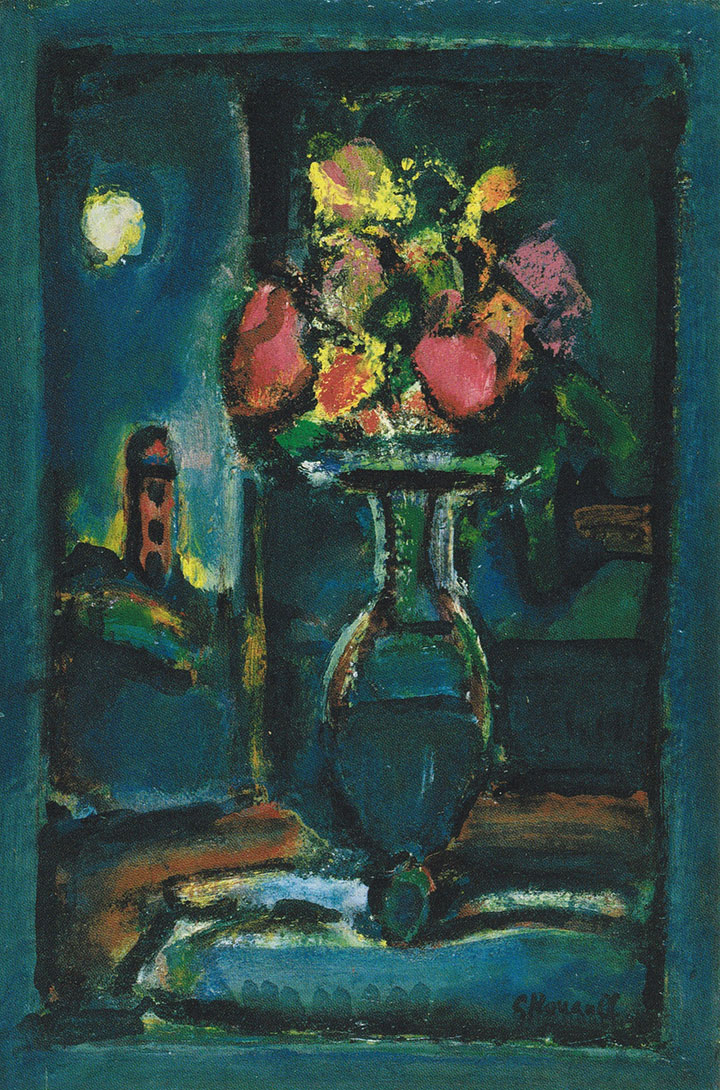
1871 - 1958
Georges Rouault
Georges Rouault’s Clown with Monkey dates from the same year as Utrillo’s Jetties on the Seine (1905).
Throughout his life, Rouault returned to a subject that was common around the end of the nineteenth century, one which he saw as a reflection of his similarly tragic existence and indeed that of humanity as a whole: the tragic, sad or solitary clown or entertainer. In his own words: “The clown? ... that’s me... that’s us … all of us.”
For a long while, this highly sensitive artist led an extremely secluded life, concealing the address of his studio from even his friends and refusing to be interviewed.
Picture:
Georges Rouault, Bouquet in a Moonlit Scene, c. 1940

1859 – 1891
Georges Seurat
On display in the Rosengart Collection are two small but important oil sketches for two key works by Seurat.
Bathers: the Seine at Asnières or Courbevoie Bridge (1883/84) is one of 15 preparatory sketches made by the artist en plein air for his first pointillist painting Bathers at Asnières (National Gallery, London).
The small oil study La Grande Jatte: the White Dog (1884/85), also painted out of doors, was executed in a “pre-pointillist” manner. This is one of 34 sketches the artist produced in connection with his monumental A Sunday on La Grande Jatte (1884-86, Art Institute of Chicago).
Picture:
Georges Seurat, La Grande Jatte: the White Dog, 1884/85

1861 - 1935
Paul Signac
Alongside Seurat, Paul Signac is another artist represented in the Rosengart Collection who, on account of his pointillist technique, can be classed as a Neo-Impressionist painter. The Harbour Entrance, St.Tropez (c. 1902) is a ravishing work that impresses with its loose handling consisting of apparently spontaneous lines and flecks that are applied to brilliant, shimmering effect.
In 1892 Signac discovered the fishing village of St. Tropez, as yet unknown to artists, which he would subsequently return to each year.
Picture:
Signac, The Harbour Entrance, St.Tropez, c. 1902
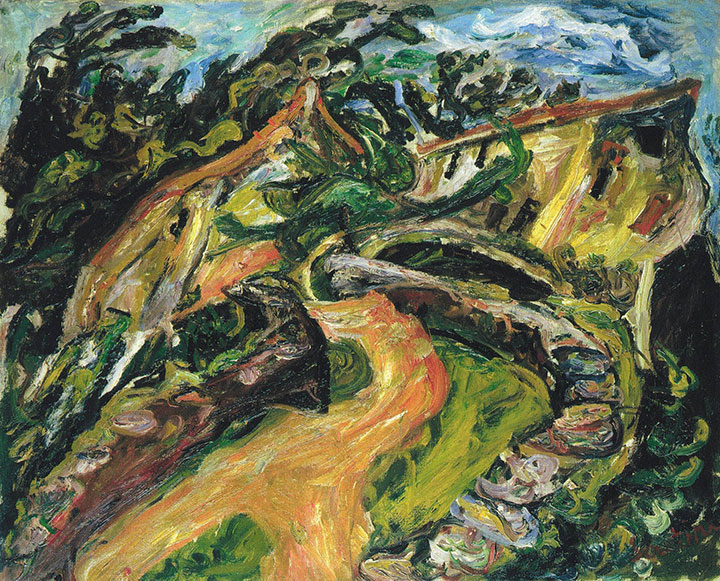
1893 - 1943
Chaim Soutine
The group of young artists around Utrillo and Modigliani were known as the peintres maudits (ostracized painters). An indissociable member of this coterie was Chaim Soutine, a Belorussian by birth who, like his fellows, rebelled against the dominance of Cubism.
Soutine had his artistic breakthrough in 1923, when the great American collector Albert Barnes bought up the entire contents of this hitherto completely unknown artist’s studio.
Soutine painted Farmhouse in Céret (Landscape with Ascending Road) in 1921 in the Pyrenees, where he was staying on the advice of his art dealer. This sojourn gave rise to intensely colourful landscapes executed with impetuous, almost passionately expressive brushstrokes.
Picture:
Chaim Soutine, Farmhouse in Céret (Landscape with Ascending Road), 1921
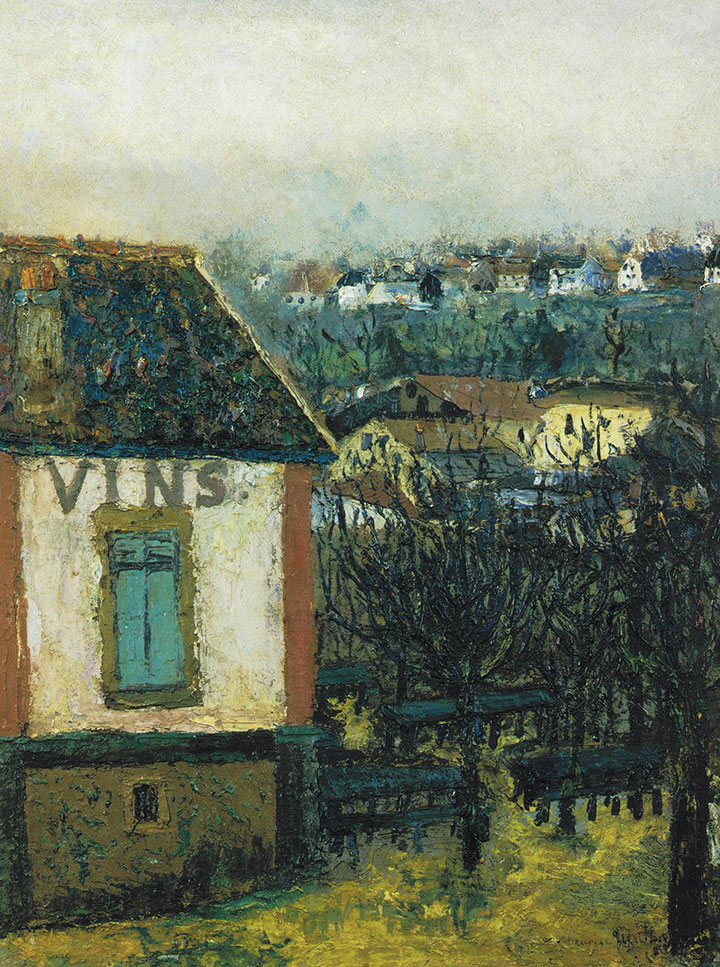
1883 - 1955
Maurice Utrillo
Jetties on the Seine (1905) is one of the earliest works by the self-taught Maurice Utrillo, whose mother was the painter Suzanne Valadon. This work captivates with its loose and vibrant, impressionistic brushwork and exuberant, shimmering use of colour. Freed from the constraint of using true-to-life colours, Utrillo bathes the buildings, trees, riverbank, barrier and wall on the left in a sea of blue tones as if in harmony with the water flowing past.
The major painting Pinson Hill, Montmagny dates from 1908. Utrillo produced a large number of works in this district to the north of Paris, where his mother had a house. In contrast to his later pictures, the artist uses impasto in this work: thanks to his thick application of the paint, the colours project relief-like above the surface of the support.
Picture:
Maurice Utrillo, Pinson Hill, Montmagny, c. 1908

1868 - 1940
Edouard Vuillard
Along with Pierre Bonnard, Maurice Denis, and Paul Sérusier, Edouard Vuillard founded the Nabis (meaning the prophets, the enlightened), a group of Symbolist artists, in Paris in 1899. With his upright-format work The Tuileries (1894), belonging to a series of paintings of public gardens, Vuillard answered the movement’s call for a new and decorative style of art. The rendering of the treetops and the paths in both the background and the foreground, the flecks of light and shadow and the wall overgrown with vegetation are all characteristic features of the style. No longer are these elements depicted by means of countless soft and indistinct dabs of paint, they are composed of larger, in part strongly delineated areas of colour. Furthermore the flat, stencil-like treetops and human figures reveal Vuillard’s engagement with Japanese woodcuts, of which he had an extensive collection.
Picture:
Edouard Vuillard, The Tuileries, 1894
